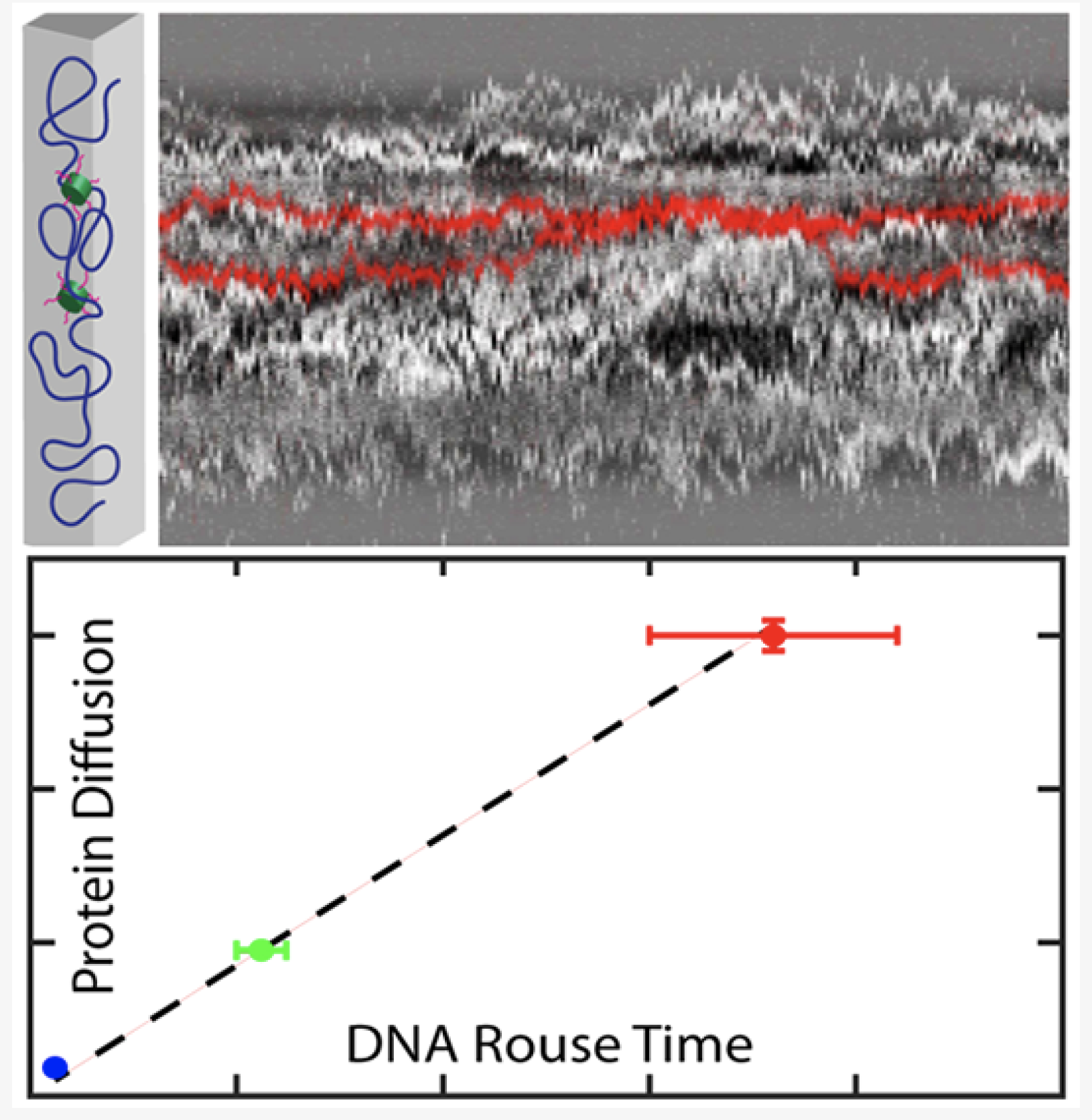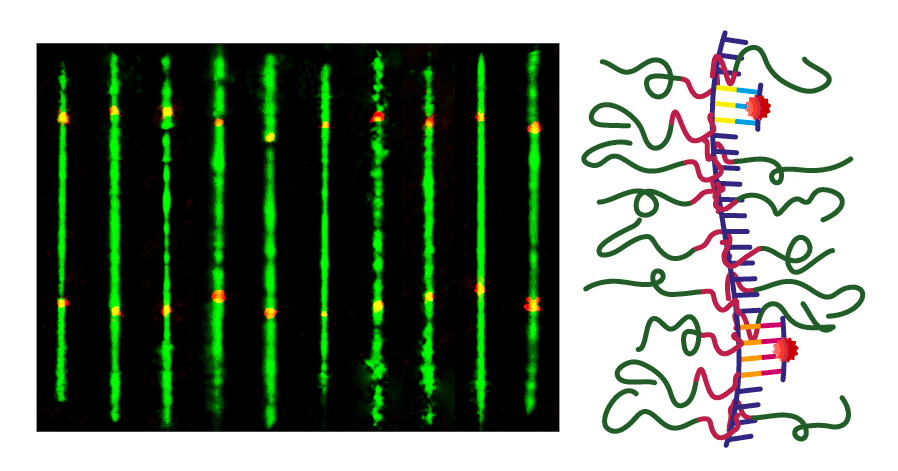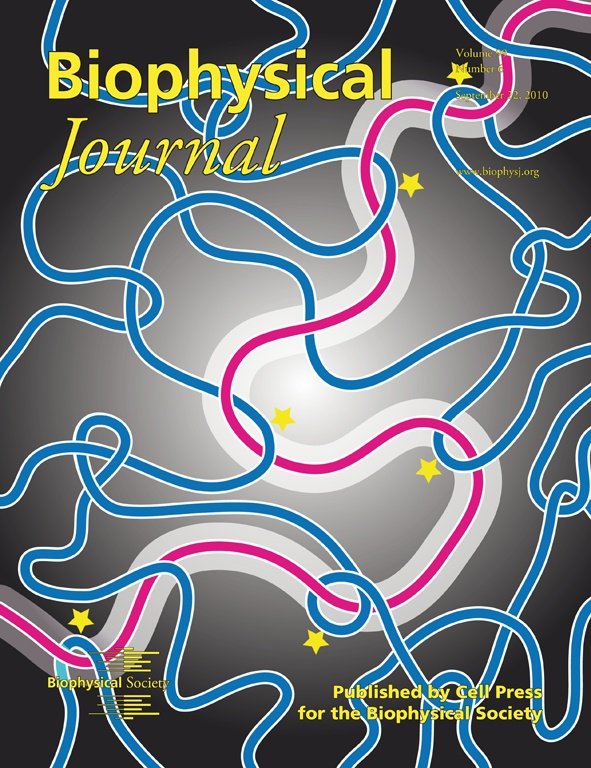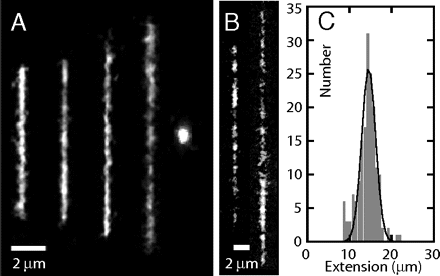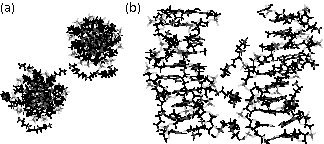Highlights
Role of DNA Internal Motion on the Mobility of a Nucleoid Associated Protein
|
Protein transport on DNA is at the core of the machinery of life. We have investigated the influence of DNA internal motion on the mobility of Hfq. Hfq is involved in several aspects of nucleic acid metabolism and is one of the nucleoid-associated proteins that shape the bacterial chromosome. Fluorescence microscopy was used to follow Hfq on double stranded DNA that was stretched by confinement to a channel with a diameter of 125 nm. The protein mobility shows a strong dependence on the internal motion of DNA in that slower motion results in faster protein diffusion. A model of intermittant diffusion is proposed that is based on three-dimensional diffusion through the interior of the DNA coil interspersed by periods in which the protein is immobilized in a bound state. We surmise that the coupling between DNA internal motion and protein mobility has important implications for DNA metabolism and protein-binding-related regulation of gene expression. The Journal of Physical Chemistry Letters 11, 8424-8429 (2020) |
|
Linearisation and Labelling of Single-Stranded DNA for Optical Sequence Analysis
|
|
Genetic profiling would benefit from linearisation of ssDNA through the exposure of the unpaired bases to gene-targeting probes. This is compromised by ssDNA's high flexibility and tendency to form self-annealed structures. Here, we demonstrate that self-annealing can be avoided through controlled coating with a cationic-neutral diblock polypeptide copolymer. Coating does not preclude site-specific binding of fluorescence labelled oligonucleotides. Bottlebrush-coated ssDNA can be linearised by confinement inside a nanochannel or molecular combing. A stretch of 0.32 nm per nucleotide is achieved inside a channel with a cross-section of 100 nm and a two-fold excess of polypeptide with respect to DNA charge. With combing, the complexes are stretched to a similar extent. Atomic force microscopy of dried complexes on silica revealed that the contour and persistence lengths are close to those of dsDNA in the B-form. Labelling is based on hybridisation and not limited by restriction enzymes. Enzyme-free labelling offers new opportunities for the detection of specific sequences. The Journal of Physical Chemistry Letters 10, 316-321 (2019) |
Control of the flow properties of DNA by topoisomerase II and its targeting inhibitor
|
DNA tangles and forms an elastic gel once the concentration exceeds a certain critical value. A test molecule (magenta) can only move in a snakelike fashion along the axial line of a tube of confinement (white), because lateral displacements are prohibited by entanglements (asterisks) with other molecules (blue). The density of entanglements and the molecular relaxation times determine the properties of the flow. Topoisomerase II is expected to play an essential role in DNA rheology, due to the removal of entanglements by the catalyzed double strand passage reaction. To test this conjecture, Kundukad and van der Maarel measured the elastic storage and viscous loss moduli of a model system composed of bacteriophage Lambda-DNA and human topoisomerase IIalpha. They observed that topoisomerase II indeed untangles DNA and transforms an initially entangled solution from an elastic gel to a viscous fluid depending on the consumption of ATP. Another aspect of their study is the effect of adenylyl-imidodiphosphate as a generic example of a topoisomerase II targeting anticancer drug. Biophysical Journal 99, 1906-1915 (2010). |
|
|
|
The effect of dextran nanoparticles on the conformation and compaction of single DNA molecules confined in a nanochannel was investigated with fluorescence microscopy. It was observed that the molecules elongate and eventually condense into a compact form with increasing volume fraction of the crowding agent. In crowded condition, the channel diameter is effectively reduced, which is interpreted in terms of depletion in DNA segment density in the interfacial region next to the channel wall. Confinement in a nanochannel also facilitates compaction with a neutral crowding agent at low ionic strength. The threshold volume fraction for condensation is proportional to the size of the nanoparticle, due to depletion induced attraction between DNA segments. Zhang, Shao, van Kan, and van der Maarel found that the effect of crowding is not only related to the colligative properties of the agent and that confinement is also important. Proceedings of the National Academy of Sciences of the United States of America 106, 16651-16656 (2009). |
Molecular dynamics simulation of multivalent-ion mediated attraction between DNA molecules
|
Molecular dynamics simulations were done to study the interaction between two parallel double-stranded DNA molecules in the presence of the multivalent putrescine (2+), spermidine (3+), spermine (4+) or cobalt hexamine (3+). The attractive force is rationalized in terms of the formation of ion bridges, i.e., multivalent ions which are simultaneously bound to the two opposing DNA molecules. The lifetime of the ion bridges is short on the order of a few nanoseconds. Physical Review Letters 100, 118310 (2008). |
|
